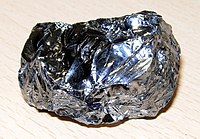
Photo from wikipedia
Amorphous cobalt-inherent silicon oxide (Co-SiOx) was synthesized for the first time and employed as a highly active catalyst in the activation of peroxymonosulfate (PMS) for the rapid oxidation of 2,4-dichlorophenol… Click to show full abstract
Amorphous cobalt-inherent silicon oxide (Co-SiOx) was synthesized for the first time and employed as a highly active catalyst in the activation of peroxymonosulfate (PMS) for the rapid oxidation of 2,4-dichlorophenol (2,4-DCP). The characterization results revealed that the 0.15Co-SiOx possessed a high specific surface area of 607.95 m2/g with a uniform mesoporous structure (24.33 nm). The X-ray diffraction patterns indicate that the substituted cobalt atoms enlarge the unit cell parameter of the original SiO2, and the selected area electron diffraction pattern confirmed the amorphous nature of Co-SiOx. More bulk oxygen vacancies (Ov) existing in the Co-SiOx were identified to be one of the primary contributors to the significantly enhanced catalytic activation of PMS. The cobalt substitution both creates and stabilizes the surficial Ov and forms the adequately active Co(II)-Ov pairs which engine the electron transfer process during the catalytic activities. The active Co(II)-Ov pairs weaken the average electronegativity of Co/Si and Co/O sites, resulting in the prevalent changes in final state energy, which is the main driving cause of the binding energy shifts in the X-ray photoelectron spectroscopy (XPS) spectra of Si and O among all samples. The increase of the relative proportion of Co(III) in the spent Co-SiOx probably causes the binding energy shifts of the Co XPS spectrum compared to that of the Co-SiOx. The amorphous Co-SiOx outperforms stable and quick 2,4-DCP degradation, achieving a much higher kinetic rate of 0.7139 min-1 at pH = 7.02 than others via sulfate radical advanced oxidation processes (AOPs), photo-Fenton AOPs, H2O2 reagent AOPs, and other AOP approaches. The efficient degradation performance makes the amorphous Co-SiOx as a promising catalyst in removing 2,4-DCP or organic-rich pollutants.
Journal Title: ACS applied materials & interfaces
Year Published: 2020
Link to full text (if available)
Share on Social Media: Sign Up to like & get
recommendations!